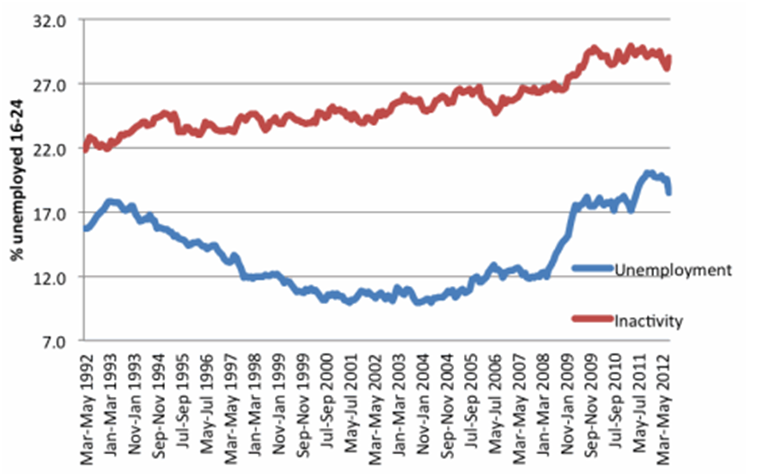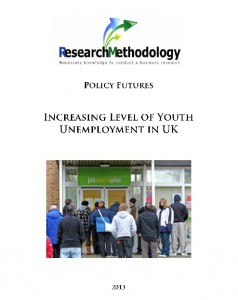Posts Tagged ‘UK’

National economy of the UK entered the period of recession on the fourth quarter of 2008. Review of literature has found consensus amongst authors about significant negative impacts of the global economic crisis of 2008-2010 on UK economy. The lowest level of recession in UK occurred in June 2009, when the decline of economy has amounted to 5.5 per cent compared to its peak in Quarter 1, 2008 (Vaitilingam, 2010). According to Bell and Blanchflower (2011), the crisis has resulted in substantial cuts on government spending, reduction on the levels of household spending, and has contributed to the emergence of uncertain and volatile investment climate. Impacts of the crisis on jobs in the UK have been analysed by Vaitilingam (2010) in a detailed manner. To be more specific, Vaitilingam (2010) assesses job-related impacts of the global economic crisis of 2008-2010 to include increase on the levels of unemployment and regional disparities in Britain’s economic geography. Additionally, Vaitilingam (2010) specifies low-educated and low-skilled employees, as well as, older workers to be most disadvantaged in terms of being negatively impacted from the crisis. Sobel (2012) draws attention to personal and emotional implications of the crisis to daily lives of people in the UK and elsewhere. According to Sobel (2012) due attention is not paid to this specific aspect of the crisis and the authors stresses the necessity for additional researches in this area. References Bell, D.N. & Blanchflower, D.G. (2011) “The crisis, policy reactions and attitudes to globalisation and jobs” WTO Sobel, A.C. (2012) “Birth of Hegemony: Crisis, Financial Revolution, and Emerging Global Networks” University of Chicago Press Vaitilingam, R. (2010) “Recession Britain: Findings from economic and social research” Economic & Research Council

Differences in Aims and Objectives in their Implications on Leadership Practices Differences in organisational aims and objectives have been found to be a significant difference between private and public sector organisations. This difference has implications on leadership practices in public and private sector organisations. In other words, usually there are clear performance indicators to assess the performances of organisational leaders in private sector and these indicators include company share prices, market share, and the levels of revenues. In cases of public sector organisations, on the other hand, performance indicators are vague, because organisational aim and objectives usually involve qualitative rather than quantitative elements. From this perspective, while the level of effectiveness of organisational leaders can be determined within a year or even shorter period of time on the basis of several quarterly performance of the organisation, longer period of time may be necessary to establish the level of effectiveness of leaders in public sector. Differences in Organisational Stakeholder Expectations and their Implications on Leadership Practices The variety and role of organisational stakeholders have been found as another point of a vast difference between private and public sector organisations. Establishing strategic relationships with stakeholders and meeting their expectations at a reasonable extent in private sector necessitates organisational leaders to adopt various roles simultaneously. In order to be successful, private sector organisational leaders need to be perceived as socially responsible by general public, they need to be perceived as dynamic and cost saving by shareholders, and at the same time organisational leaders need to be perceived as caring and motivational by the workforce. Arguably, meeting stakeholder expectations in public sector is less contradicted compared to meeting stakeholder expectations in private sector from leadership viewpoint. This is because in most cases no stakeholder group expects profit maximisation from public sector organisations, and…

On May 1, 2004 the European Union (UN) has been enlarged to comprise additional ten countries with combined population of almost 75 million people. Specifically, new countries that formally entered EU consist of Estonia, Latvia, Lithuania, Poland, Czech Republic, Hungary, Slovakia, Slovenia, Cyprus and Malta. This important geo-political event has had significant implications on national economic, social and political life of all original member countries of the EU (Europa, 2013, online).This essay analyses the impacts of EU enlargement on the state of national economy in the UK focusing on labour migration. The essay starts with discussions about the reasons for the enlargement of EU in 2004. This is followed by analysis of implications of enlargement of EU to the state of national economy in the UK as compared to expectations. Moreover, the essay is going comprises the overview of measures initiated by the UK government in order to address the potential negative implications of the EU enlargement on the state of the national economy in the UK. The essay is concluded by discussing various scenarios in the development of immigration policies in the UK with the aims of protecting national economy from negative impact of a range of internal and external factors. After the fifth EU enlargement in 2004, the majority of Western European countries (EU15) have introduced temporary restrictions on the movement of individuals from newly EU member states in order to protect their national economies from the large uncontrolled inflow of low-skilled immigrants. Such restrictions were not applied only by the UK, Ireland, and Sweden (Longhi and Rokicka, 2012), and the implications of this government decision for the UK are assessed further below. Introduction 1 Reasons for the enlargement of EU in 2004 2 Implications of enlargement of EU to the state of national economy in the UK…

Unemployment is serious social and economic issue for the society, and unemployed individuals in many levels. Unemployment amongst young people is considered to be a special case as “young people between their required school life and their first job are very susceptible to unemployment” (Kurten, 2007, p.3). Moreover, a high level of youth unemployment has massive negative implications for the government on short-term and long-term perspectives. According to International Labour Office (2012), individuals aged between 16 – 25, who are available for work in 15 days, not currently employed, and are looking for employment opportunities in an active manner can be classified as young unemployed. However, in the UK, the age range of young unemployed individuals is specified as 16 – 24 years old. The level of youth unemployment has been consistently rising in the UK during the past several years (Figure 1). Moreover, it has been estimated that the numbers of young individuals who have not been working for more than 2 years have increased from 40,000 to more than 100,000 during the last four years, amounting to the increase of 168 per cent, and the numbers of Job Seeker Allowance claimants amongst young people have increased 315 per cent during the last six month (Al-Katib, 2012). Figure 1 Youth unemployment and inactivity statistics Source: Office of National Statistics (2012) The lack of skills and experience amongst young people in the UK is considered to belong to the list of major reasons behind increasing level of unemployment. Moreover, continuing economic problems in the EU and the UK have been found to have negative implications on the local job market in UK in general, and the job market for young people in particular. There is a stark difference on the levels of employment amongst young people who are engaged in…

This paper represents a case study report devoted on the issue of increasing levels of youth unemployment in the UK. The report starts with a brief description of relevant existing key policies. This is followed by the identification of gaps on youth unemployment that need to be addressed. The report also contains discussions about relevant policy goals and the extent of their alignment with government preferences. Moreover, relevant policy options analyses are included in this report with detailed explanations of two the most suitable and appropriate policy options taking into account present economic and political circumstances in the UK. The report is concluded by making recommendations regarding the implementation of a specific policy option with detailed explanations provided. Youth unemployment is proving to be a serious challenge in the UK with highly negative short-term and long-term economic and social implications. Specifically, nearly 1.5 million, or more than 20 per cent of young people in the UK are found to be not engaged in education, employment or training (ACEVO, 2012). Moreover, according to estimations, the net present value cost of youth unemployment for the next ten years is going to amount to £28 billion (ACEVO, 2012). A wide range of negative implications of youth unemployment include negative impact on national economy for short-term and long-term perspectives, negative impact on future earning potentials of youth involved, detrimental impacts on mental and individual health of young individuals involved (Gregg et al., 2011), and increase in the level of anti-social behaviour within the society (Howell, 2005). The major reasons for increasing levels of youth unemployment in the UK have been specified as the recent global economic and financial crisis, failure in the UK immigration policies (Sunley et al., 2011), and systematic employment policy failures (Furlong, 2012). 1. Introduction: Nature of the Problem 1 2.…

Global forces impacting UK businesses include, but not limited to increasing scale of international trade, increasing levels of multiculturalism in UK organisations, increasing levels of inter-dependency of national economies and others. The impact of global forces on UK Business Organisations can be effectively analysed using PESTEL analysis where the abbreviation stands for political, economical, social, technological, ecological, and legal factors impacting businesses. The following table contains the application of PESTEL analysis in relation to businesses operating in the UK. Political The level of global political stability The level of bureaucracy in international affairs The extent of freedom of media Global trade control initiatives Threat of international terrorism Tariffs between the UK and other countries Global copyright, patent and intellectual property disputes Economical Impacts of intensifying economic globalisation Global economic crisis Sock market fluctuations Cost advantages possessed by emerging superpowers such as China, India etc. Impact of The World Bank and The World Trade Organisation Increasing importance of outsourcing and offshoring initiatives Social Changes in family values in global scale Changes in family patterns (same-sex marriages, single parents etc.) Increasing popularity of immigration and migration practices Increasing mobility between social classes Greater concern for minorities in society Technological Level of global technological infrastructure Industry-specific technological breakthroughs Regular emergence of innovative communication technologies Adoption of technology as competitive edge by increasing numbers of businesses Ecological Impacts of global warming tendencies Increasing levels of air and pollution Increasing level of sensitivity towards “green” problems among business stakeholders Activities and initiatives of global environmental organisations Legal Laws and regulations related to data protection Global data protection rules and regulations Increasing levels of “legal globalisation” Changes in cross-country employment and health and safety laws The case studies of Martin Lishman and Aquaco mentioned above represent a few cases where UK businesses benefit from…

Resource allocation plays an integral role in facilitation of a national economy in any country. Economic systems can be centrally-panned, free, and mixed and economic systems have a direct impact on the nature of resource allocation. UK has a free market economy, and accordingly resource allocation in the UK is facilitated purely according to the forces of supply and demand. In centrally-planned economies, on the contrary, such as former USSR “resource allocation plans and decisions are made by central government and then promulgated through government agencies” (Folsom and Boulware, 2004, p.58). In mixed economic systems, such as in China and present state of former USSR members, there are elements of both, free market and centrally-planned economies to varying proportions. The extent of presence free market and centrally planned elements in each mixed economy depends on a range of factors such as political agenda, the level of corruption, the levels of dependency on exports and imports etc. The effectiveness of free market economy such as in the UK has been traditionally perceived to be greater compared to alternative types of economies in terms effective resource allocation. However, global economic and financial crisis of 2008-2010 and its continuing implications have shed a light on inefficiencies associated with free market economy. Fiscal policy is a type of government economic policies that affect macroeconomic situation in the country. Impact of fiscal policy on businesses is evident and straightforward and this impact is facilitated through taxation, and the levels of government spending. Monetary policy is can be defined as government economic policy to control the supply of money through interest rates. In the UK the monetary policy is conducted by The Bank of England, whereas in Russia the Central Bank of Russia is responsible for monetary policy. The importance of adequate fiscal and monetary policies…

According to Hofstede’s model for cultural differences and analysis between China and UK, the following table has been produced in reference to the link provided. Adopted from: http://www.geert-hofstede.com/hofstede_dimensions.php?culture1=94&culture2=18#compare According to power distance index, the Chinese understanding of power distribution and inequality is more than two times higher than the UK expectations. This indicates that the Chinese team management style is inclined to one person in the organization to have higher power than others and that person is perceived to be in a higher position than others. And according to individualism aspect of the above table, theUKorganization culture tends to have more individualistic approach than that ofChina. This indicates that individualism is more developed inUKcompanies and team management than Chinese. The reaction to risk in both countries tends to be in a very similar level. However, in terms of planning, the UK culture indicates to have short term planning, whereas, the Chinese to be long term planning. Based on above analysis, it can be concluded that the following type of management would be most appropriate to operate the business unit effectively in China: The management style similar to autocratic, where management tends to have more power to run the company as collectivism is highly appreciated in Chinese organizations. This indicates that subordinates are happy to follow the leader. In terms of planning skills of management, a manager with long term planning goals should be most appropriate here as Chinese management and employees tend to think well into future. Gender does not make big difference as both countries tend to have same levels of approach to genders, according to table above. Therefore, a person who can work collectively with others, more challenging towards others and risk aware would be ideal for the manager position here. The person suitable for this position…

Presence of world’s leading retailers such as Tesco, Sainsbury’s and Marks & Spenser, fierce competition in pricing and in other terms and difficulties of market entry are the main characteristics of UK retail industry. Despite such complexities, some retailers could manage to do better during the recession achieving even higher revenues and profits. Although lack of financial resources and higher risk aversion by investors caused many difficulties for the retailers, some of the retailers introduced new strategies such as price cut downs and reinforcing their current positions rather than expanding, which helped them sustain the temporary difficulties and overcome the recession. Two types of factors, direct and indirect impacts of recent financial recession on consumer spending during and after crisis have been discussed in the report of Office for National Statistics. Direct impacts are said to be uncertainty of income and high rates of unemployment with scarcity of finance to support public spending by the governments. Indirect impacts on the other hand are credit crunch of financial organizations which makes them unable to process their businesses of providing loans the businesses. The research by Burt et al (2009) analyse and examine the impacts of financial crisis on the consumer buying behaviour in the UK and lists the following factors that had direct impact on the consumer spending: job uncertainty, declining savings, increased risk aversion and lower disposable income. Due to these factor consumers restrained themselves from excessive spending as they used to and focused mostly on important things. Respondents who participated in the study expressed their opinions saying that due to uncertainty in their future income or at least decline in the income they no longer can afford to spend excessively as previously. As it has been stated earlier, disposable income is considered to be one of the main effects…

It is important to mention the value and importance of the retail industry to the economy of the UK. According to Mintel Report (2009), retail industry of the UK is considered to be highly important and contributing factor to the UK economy as it generates 16% of UK Gross Domestic Product. In addition, every third pound is generated through retailers and almost 11% of the UK workforce is employed in this industry. UK has some retail companies that are internationally recognized and growing rapidly. For example, only Tesco has more than 1100 stores within the UK and overseas and planning to expand towards emerging markets such as Hong Kong and India. It is also worth stating that according to Mintel Report (2009) despite high importance and value, UK retailers are considered to be low employee payers although senior level managers are paid relatively well. The period of recent financial crisis in the UK was from the second quarter of 2008 to the third quarter of 2009. It started with 6.4% decline in Gross Domestic Product of UK in the beginning of the period and started increasing by 0.4% only at the end of the period. During the recession, UK economy deteriorated continuously leading to high rates of unemployment which is about 5% at the end of the period. This accounted to 800,000 people out of job (Gooberman, 2010). Another aspect of UK economy and its vulnerability to the financial recession has been discussed in the study conducted by LSE (2008). According to the research, UK economy is vulnerable to the financial crisis due to its reliance and specialization mostly on financial services and trading activities. Decline of the importance of the financial sectors had more negative effect on overall UK economy as a result of higher unemployment rate in the…
